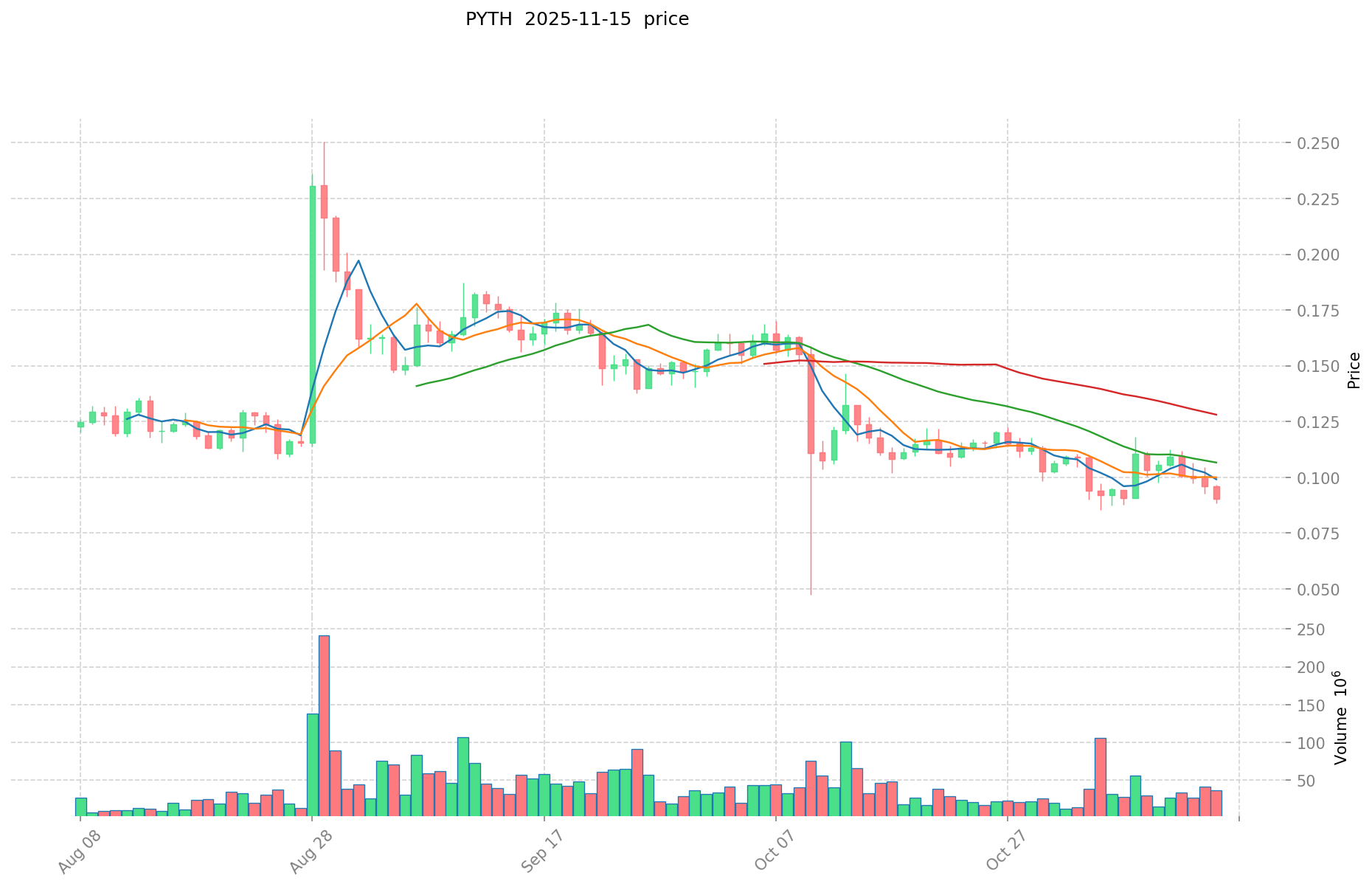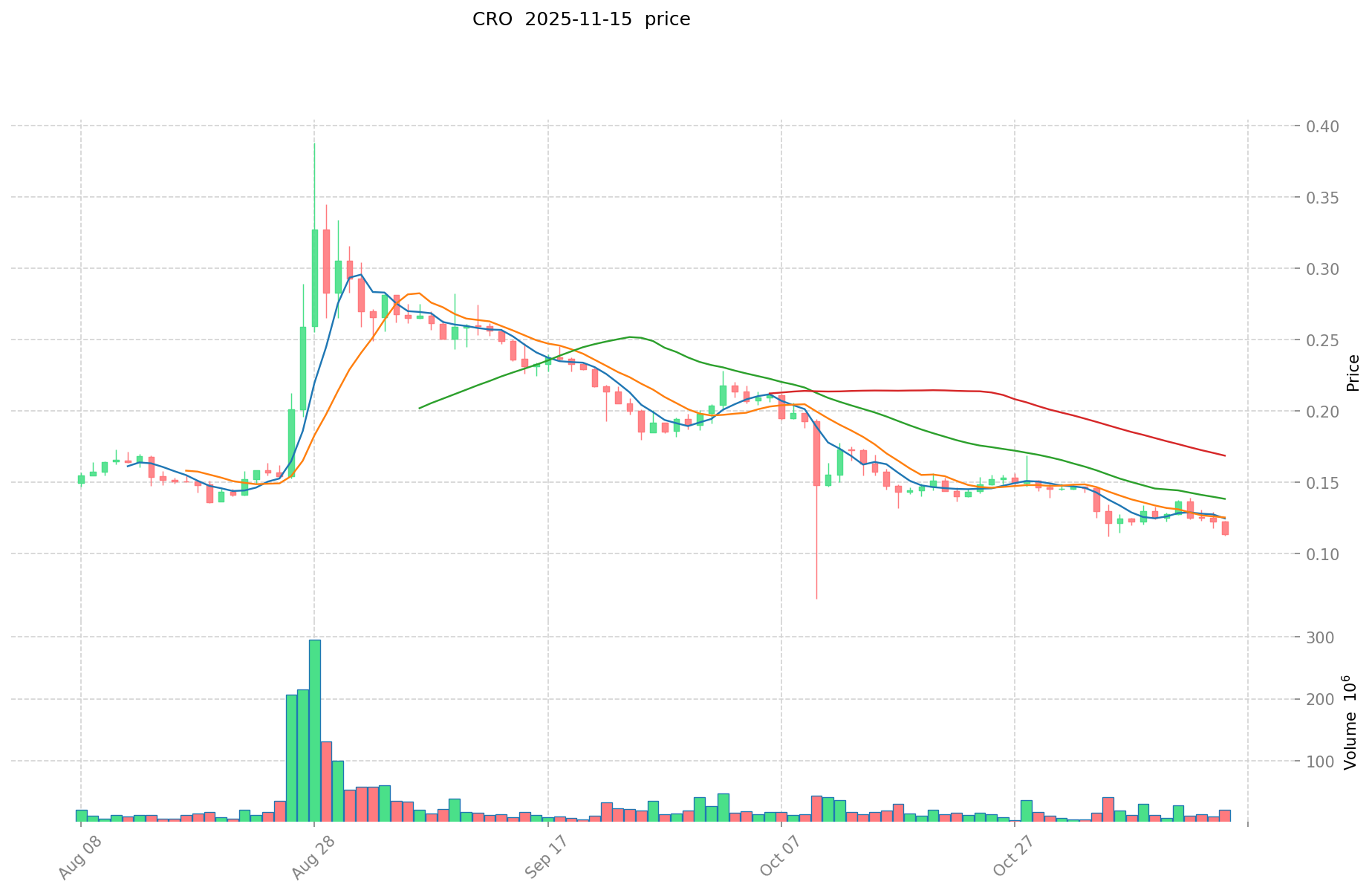PYTH vs CRO: A Comparative Analysis of Two Emerging Crypto Ecosystems
Introduction: PYTH vs CRO Investment Comparison
In the cryptocurrency market, the comparison between Pyth Network vs Cronos has always been a topic that investors can't avoid. The two not only have significant differences in market cap ranking, application scenarios, and price performance, but also represent different positioning in the crypto asset space.
Pyth Network (PYTH): Since its launch, it has gained market recognition for its role as an oracle that publishes financial market data to multiple blockchains.
Cronos (CRO): Since its inception in 2018, it has been hailed as a leading blockchain ecosystem, partnering with Crypto.com and over 500 application developers and contributors.
This article will provide a comprehensive analysis of the investment value comparison between PYTH vs CRO, focusing on historical price trends, supply mechanisms, institutional adoption, technological ecosystems, and future predictions, attempting to answer the question that concerns investors the most:
"Which is the better buy right now?"
I. Price History Comparison and Current Market Status
PYTH (Coin A) and CRO (Coin B) Historical Price Trends
- 2024: PYTH reached its all-time high of $1.1552 on March 16, 2024.
- 2025: CRO experienced a significant decline, with its price dropping by 22.36% over the past year.
- Comparative analysis: In the current market cycle, PYTH has fallen from its all-time high of $1.1552 to $0.09336, while CRO has dropped from its all-time high of $0.965407 to $0.11666.
Current Market Situation (2025-11-15)
- PYTH current price: $0.09336
- CRO current price: $0.11666
- 24-hour trading volume: PYTH $3,047,180.31 vs CRO $2,001,021.58
- Market Sentiment Index (Fear & Greed Index): 10 (Extreme Fear)
Click to view real-time prices:
- Check PYTH current price Market Price
- Check CRO current price Market Price


II. Key Factors Influencing PYTH vs CRO Investment Value
Supply Mechanisms Comparison (Tokenomics)
- PYTH: Token supply is capped at 10 billion tokens with a distribution schedule spanning 5-10 years
- CRO: Fixed maximum supply of 30 billion tokens with regular burning mechanisms reducing circulating supply
- 📌 Historical Pattern: Deflationary models like CRO's token burning have historically created supply pressure supporting price stability, while PYTH's extended distribution schedule provides longer-term alignment for network participants.
Institutional Adoption and Market Applications
- Institutional Holdings: PYTH has secured backing from Jump Crypto, DRW Cumberland and other major trading firms, while CRO benefits from Crypto.com's established institutional relationships
- Enterprise Adoption: PYTH powers over 290 applications across multiple blockchains, primarily in DeFi price feeds; CRO serves as utility token within Crypto.com's payment and trading ecosystem
- Regulatory Stance: Both tokens operate in evolving regulatory landscapes, with CRO benefiting from Crypto.com's established compliance framework
Technical Development and Ecosystem Building
- PYTH Technical Upgrades: Recent cross-chain expansion to 29+ blockchains including Ethereum, Solana, and Arbitrum, implementing advanced price aggregation algorithms
- CRO Technical Development: Transition from ERC-20 to native Cronos blockchain, supporting smart contracts and cross-chain interoperability
- Ecosystem Comparison: PYTH focuses on DeFi data infrastructure with growing adoption in trading protocols; CRO ecosystem encompasses exchange services, payment solutions, and expanding DeFi applications on Cronos chain
Macroeconomic Factors and Market Cycles
- Inflation Performance: CRO's fixed supply model theoretically provides better inflation resistance, while PYTH's utility in price discovery may offer resilience during market volatility
- Monetary Policy Impact: Both tokens show correlation to broader crypto market responses to interest rate changes and dollar strength
- Geopolitical Factors: CRO's global payment capabilities provide utility during cross-border transaction demand, while PYTH's oracle services remain essential regardless of geopolitical tensions
III. 2025-2030 Price Prediction: PYTH vs CRO
Short-term Prediction (2025)
- PYTH: Conservative $0.0876-$0.09321 | Optimistic $0.09321-$0.102531
- CRO: Conservative $0.1108365-$0.11667 | Optimistic $0.11667-$0.1423374
Mid-term Prediction (2027)
- PYTH may enter a growth phase, with an estimated price range of $0.093172716-$0.158941692
- CRO may enter a volatile phase, with an estimated price range of $0.07661438892-$0.2178252234
- Key drivers: Institutional capital inflow, ETF, ecosystem development
Long-term Prediction (2030)
- PYTH: Base scenario $0.1721985252624-$0.201472274557008 | Optimistic scenario $0.201472274557008+
- CRO: Base scenario $0.242314599701475-$0.307739541620873 | Optimistic scenario $0.307739541620873+
Disclaimer: This analysis is based on historical data and market projections. Cryptocurrency markets are highly volatile and unpredictable. This information should not be considered as financial advice. Always conduct your own research before making investment decisions.
PYTH:
| 年份 | 预测最高价 | 预测平均价格 | 预测最低价 | 涨跌幅 |
|---|---|---|---|---|
| 2025 | 0.102531 | 0.09321 | 0.0876174 | 0 |
| 2026 | 0.12135942 | 0.0978705 | 0.07242417 | 5 |
| 2027 | 0.158941692 | 0.10961496 | 0.093172716 | 17 |
| 2028 | 0.16650512424 | 0.134278326 | 0.10339431102 | 44 |
| 2029 | 0.1940053254048 | 0.15039172512 | 0.120313380096 | 61 |
| 2030 | 0.201472274557008 | 0.1721985252624 | 0.161866613746656 | 85 |
CRO:
| 年份 | 预测最高价 | 预测平均价格 | 预测最低价 | 涨跌幅 |
|---|---|---|---|---|
| 2025 | 0.1423374 | 0.11667 | 0.1108365 | 0 |
| 2026 | 0.170944884 | 0.1295037 | 0.124323552 | 11 |
| 2027 | 0.2178252234 | 0.150224292 | 0.07661438892 | 28 |
| 2028 | 0.237391937433 | 0.1840247577 | 0.167462529507 | 57 |
| 2029 | 0.27392085183645 | 0.2107083475665 | 0.111675424210245 | 80 |
| 2030 | 0.307739541620873 | 0.242314599701475 | 0.198697971755209 | 108 |
IV. Investment Strategy Comparison: PYTH vs CRO
Long-term vs Short-term Investment Strategies
- PYTH: Suitable for investors focused on DeFi infrastructure and data oracle potential
- CRO: Suitable for investors interested in exchange ecosystems and payment solutions
Risk Management and Asset Allocation
- Conservative investors: PYTH: 30% vs CRO: 70%
- Aggressive investors: PYTH: 60% vs CRO: 40%
- Hedging tools: Stablecoin allocation, options, cross-currency portfolios
V. Potential Risk Comparison
Market Risks
- PYTH: Volatility due to nascent oracle market and competition from established players
- CRO: Exposure to broader crypto exchange market fluctuations and competition
Technical Risks
- PYTH: Scalability, network stability across multiple blockchains
- CRO: Centralization concerns, potential security vulnerabilities in the Cronos chain
Regulatory Risks
- Global regulatory policies may impact both differently, with CRO potentially facing more scrutiny due to its connection with a centralized exchange
VI. Conclusion: Which Is the Better Buy?
📌 Investment Value Summary:
- PYTH advantages: Cross-chain oracle capabilities, growing DeFi adoption, institutional backing
- CRO advantages: Established ecosystem, Crypto.com partnership, deflationary tokenomics
✅ Investment Advice:
- New investors: Consider a balanced approach with a slight bias towards CRO for its more established ecosystem
- Experienced investors: Explore a higher allocation to PYTH for potential growth in the oracle space
- Institutional investors: Consider both for different portfolio needs - PYTH for DeFi exposure, CRO for broader crypto ecosystem involvement
⚠️ Risk Warning: The cryptocurrency market is highly volatile, and this article does not constitute investment advice. None
VII. FAQ
Q1: What are the main differences between PYTH and CRO? A: PYTH is an oracle network providing financial market data to multiple blockchains, while CRO is the native token of the Cronos blockchain ecosystem, associated with Crypto.com. PYTH focuses on DeFi data infrastructure, whereas CRO has a broader application in exchange services and payment solutions.
Q2: Which token has performed better in terms of price history? A: In the current market cycle, PYTH has fallen from its all-time high of $1.1552 to $0.09336, while CRO has dropped from its all-time high of $0.965407 to $0.11666. CRO has maintained a slightly higher current price, but both have experienced significant declines from their peak values.
Q3: How do the supply mechanisms of PYTH and CRO differ? A: PYTH has a capped supply of 10 billion tokens with a distribution schedule spanning 5-10 years. CRO has a fixed maximum supply of 30 billion tokens with regular burning mechanisms reducing circulating supply, potentially creating deflationary pressure.
Q4: What are the key factors influencing the investment value of PYTH and CRO? A: Key factors include supply mechanisms, institutional adoption, market applications, technical development, ecosystem building, and macroeconomic factors such as inflation performance and monetary policy impact.
Q5: What are the long-term price predictions for PYTH and CRO by 2030? A: For PYTH, the base scenario predicts a range of $0.1721985252624-$0.201472274557008, with an optimistic scenario above $0.201472274557008. For CRO, the base scenario predicts a range of $0.242314599701475-$0.307739541620873, with an optimistic scenario above $0.307739541620873.
Q6: How should investors approach risk management when investing in PYTH and CRO? A: Conservative investors might consider allocating 30% to PYTH and 70% to CRO, while aggressive investors might allocate 60% to PYTH and 40% to CRO. Hedging tools such as stablecoin allocation, options, and cross-currency portfolios can also be used to manage risk.
Q7: What are the potential risks associated with investing in PYTH and CRO? A: Both tokens face market risks related to volatility and competition. PYTH has technical risks concerning scalability and network stability across multiple blockchains, while CRO faces potential centralization concerns. Both are subject to regulatory risks, with CRO potentially facing more scrutiny due to its connection with a centralized exchange.
Share
Content